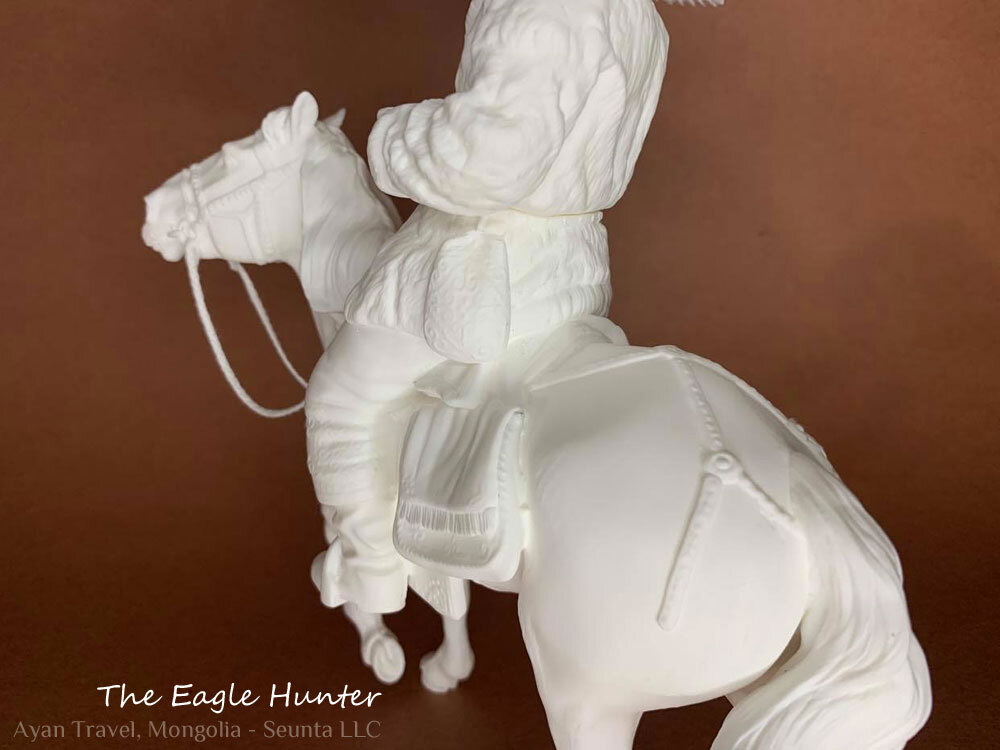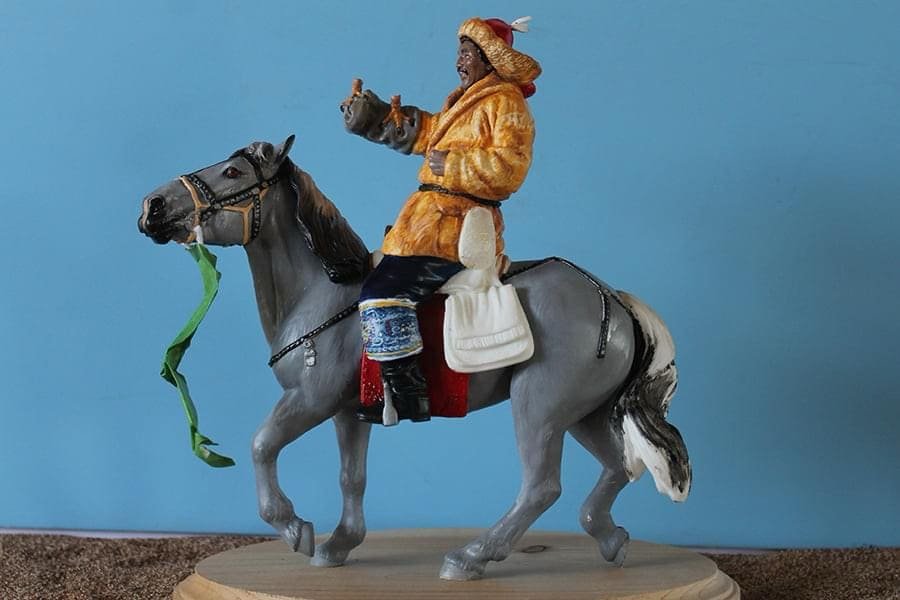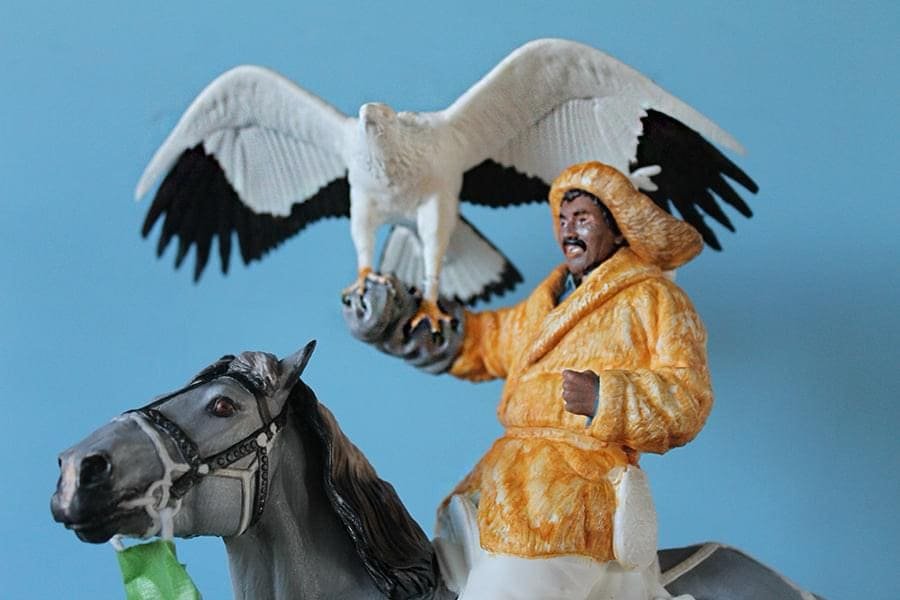The Eagle Hunter 1:9












































The Eagle Hunter 1:9
The Eagle Hunter
by Enkhtur Bayarsaikhan
1:9 scale (small Mongolian horse), overall dimensions: 9" (nose to tail) x 10" (to top of eagle)
width: 6.5" (eagle wing tips to muzzle)
MODEL SIZES: details on all sizes/scales
Stainless steel wire support in: Horse - all 4 legs and tail, Rider - body, arm, and feathers on the headpiece, Eagle - both wing spans and both legs.
UPDATE: Reins are included but are not attached as people have preferred to customize the length.
This model is shipped in two sections with easy guides to attach (eagle to arm). Reins are included. They are long enough to reach his hand even though it is not photographed that way.
Small pieces not included with his gear are: the lead line, the whip and the leaning stick. White resin with stainless steel reinforcement. No prepping is done.
The Eagle Hunter was commissioned by Batzaya Photography and Ayan Travel, Mongolia. This resin edition is being made for the Eagle Festival in Mongolia (sculpted by Enkhtur and cast by Seunta). Permission has been given to allow copies to be distributed by Seunta LLC.
Eagle Hunter
artisan gallery
Gallery photos are of painted resin models that have been finished by various artists, worldwide.
There may be customizing to some of the models in the gallery.








Eagle Hunter Gear
There are a few gears specifically made and used for taming eagle and during hunting. They have their specific names.
1. Leg straps /balakhbau - балақбау/:
Leg straps used to strap the legs of the eagle to prevent it from flying away is called “balakhbau”. Balakhbau consists of two parts: straps and the cord. Straps are made out of soft leather, in the form of a bracelet, so that it does not squeeze the baby and rotates freely. The inside of the strap is lined with a soft cloth and felt to prevent any bruises. The radius of the strap is about the thickness of the bird's calf, and the width is about 4-6 cm.
Balakhbau’s cord is knit halfway and has a loop in one end. The cord is about 20-30 cm long.
2. Glove /biyalai - биялай/:
A type of glove made of durable leather, worn by the eagle hunter on the right hand, with sleeves extending to the elbows. Biyalay should be 50 cm long and wide enough to fit the sleeves of winter clothes (about 30 cm). It is made of thick skin of camels, oxen, and mountain goats. The hairy surface of the skin is turned inwards and lined with thick felt. After putting on the bird, the bird goes and puts it in his hands. The sharp claws of a golden eagle, which has one of the sharpest claws in the world, should not pass through the “biyalai” when it is squeezed.
3. Leaning stick /baldakh - балдақ/:
This is an important gear for eagle falconry on horseback. A leaning stick used to keep a hunter from getting hurt or tired while riding a horse with an eagle sits on the hand. Because the golden eagle is giant raptor, weighs up to 6.5 kg. This gear is called “baldakh’, which is made out of branches of either birch or brushwood and is about 50cm long and has a cushion on one to prevent it from bruising the horse's spine. The upper part of the “baldakh’ is wide enough to fit the hand. Hunting becomes easy with the help of “baldakh”.
4. Foodsack /djem khalta – жем қалта/:
Food-sack used to store meat to feed an eagle while hunting is called “djem khalta”. It is made out of felt and cotton as inside to prevent meat to be frozen in the winter. The size of “djem khalta” is about 25cm by 20 cm and the strap of it is about 30 cm.
5. Kazakh eagle falconer clothes
The two most unique types of clothing worn by Kazakh hunters for eagle hunting are sheep skin trousers and leather outwear/deel/. The leather deel is a traditional dress worn by ancient nomads in Central Asia. The leather is thin, light and its hair is short, so it is well softened and suitable for sewing vests. When the fabric was scarce, the inside was sewn without lining the fabric, and later lined with fabric. This kind of clothes must be suit for movements, and horse riding. The deel/outerwear is short and the trousers must be wide. Kazakh clothes are so decorative and in addition they sew colorful traditional patterns on their clothes which symbolized many beliefs and cultural uniqueness.
6. Travel bag or travel pack
Sometimes, eagle hunters go hunting for several days that depends on the preys, land, weather condition, distance of the hunting spot and other matters. This kind of travel pack is very convenient for long distance travel on horseback. Inside the pack, there are all basic belongings of the hunter and some foods. The bag is made from canvas or leather.
The Eagle Hunter on Horseback in Mongolia
In the remote Altai mountains of Mongolia, the coexistence of wonderful falconry tradition and ancient nomadic culture, still living today. There are many countries where the falconry is still practicing in the world. But the old tradition, the classic form of eagle falconry is living just in western Mongolia.
When the winter comes, a falconer goes for a hunt with his trained eagle on horseback. The eagle hunter or master holds his eagle on his right hand while riding a horse. They search for wild prey through the ragged mountains and when the prey is detected, human master and trained eagle hunt the wild prey together. The specialty of this old falconry is about the bond between horse, eagle and human and when it works well the hunt would be successful. In the Kazakh proverb; “Fine horses and fierce eagles are the wings of the Kazakh”. Horse is very important and must be well trained as same as eagle in this falconry tradition.
It can’t be imagined that the Kazakh men without eagles because eagle hunting has become a tradition from some 6000 years. The eagle is the most respectful animal for the Kazakh people, after they bring new eagle to their home that eagle becomes one of the family members and has special holy area, the most respectful place in the home/yurt of its human master.
Men bring the female eaglet or female adult eagle from the wild for training to hunt because the female eagle is stronger, bigger and more aggressive than the male ones. After bringing it, all elders gather and then they name their eagle and make some welcoming rituals.
During the warm season, eagles must be trained and in the late autumn the eagle can be ready to hunt with its master. The hunting season starts from the beginning of October when the first snow falls and continues to the 15th of March. During spring time, they don't go for hunting because of the preys' mating season starts. So during this time the eagles are fed by its human masters with domestic animals' meat. When summer comes, the eagles are allowed to hunt small mammals, such as mice, marmot and hare.
After 6 or 7 years of hunting the eagle must be released back to the wild. Hunters give whole mutton to the eagle when sending them /eagle/ to the wild nature and there have to be held the farewell rituals. This is so tragic moment for both the hunter and the eagle.
The Sagsai Golden Eagle Festival in Mongolia
The Sagsai Golden Eagle Festival is a cultural and adventurous attraction for both local and foreign visitors. It is not just about a festivity, but also is about the ancient hunting tradition and unique cultural heritage of Kazakh minority in Mongolia. The festival allows us to see and know more about the old traditions of hunting with eagles in a short period. It gives us a chance to get deep knowledge and authentic experience of centuries-old culture in just 2 days.
There are about 250 eagle hunters who practice this traditional eagle falconry and they gather to show off their horse skills, sharing and learning experiences of eagle training with each other. The festival is also an important event for checking out the training result of the eagles, before the winter hunting begins.
The most eagle falconers are from Sagsai village of Bayan-ulgii province so we organize “The Sagsai Golden Eagle Festival” in Sagsai village which is held annually, on 17 -18th of September. The Sagsai Golden Eagle Festival offers us great opportunity to explore and document all of these cultural experiences and in addition, there are specific sessions and programs for photographers and film makers. The Sagsai festival is not so touristy event and it gives a great freedom to enjoy, also the festival directly contributes the local eagle hunters and their family who keep this wonderful tradition.
The eagle hunter sculpture is being made to promote this place where the most of the eagle hunters reside who practice the old falconry tradition. The Sagsai Golden Festival is the major part of the “AYAN” Project which aims to help keeping this wonderful human culture through photography and contributes the local eagle hunters who have passion to keep their cultural heritage.
© All rights to the sculpture of The Eagle Hunter reserved by Batazaya Choijiljav.



